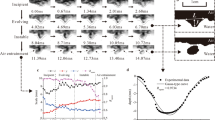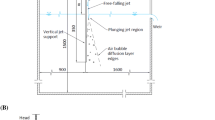Abstract
This study investigates energy dissipation due to air bubble entrainment for three typical phenomena; a hydraulic jump, a 2-D vertical plunging jet and a vertical circular plunging jet into water. A simple model is presented here which enables to estimate the energy transformation and dissipation achieved by air bubbles quantitatively for three above phenomena. The average rate of energy dissipation by air bubbles obtained from the experimental data are 25%, 1.4%, and 2.15% with respect to total energy loss for the hydraulic jump, 2-D vertical plunging jet and vertical circular plunging jet, respectively.
Similar content being viewed by others
References
A.K. Bin (1993) ArticleTitleGas entrainment by plunging liquid jets Chem. Eng. Science 48 3585–3630 Occurrence Handle10.1016/0009-2509(93)81019-R
F. Bonetto R.T. Lahey (1993) ArticleTitleAn experimental study on air carry under due to a plunging liquid jet Int. J. Multiphase flow 19 281–294 Occurrence Handle10.1016/0301-9322(93)90003-D
H. Chanson L. Toombes (2002) ArticleTitleExperimental study of gas–liquid interfacial properties in a stepped cascade flow Environ. Fluid Mech. 2 241–263 Occurrence Handle10.1023/A:1019884101405
H. Chanson T. Brattberg (2000) ArticleTitleExperimental study of the air–water shear flow in a hydraulic jump Int. J. Multiphase Flow 26 583–607 Occurrence Handle10.1016/S0301-9322(99)00016-6
H. Chanson (1997) Air Bubble Entrainment in Free-surface Turbulent Shear Flow Academic press London, U.K.
H. Chanson J.F. Lee (1997) ArticleTitlePlunging jet characteristics of plunging breakers Coastal Eng. 31 125–141 Occurrence Handle10.1016/S0378-3839(96)00056-7
.D. Cummings H. Chanson (1997) ArticleTitleAir entrainment in the developing flow region of plunging jets-part 2: experimental J. Fluids Eng. 119 603–608
G.M. Evans G.J. Jameson B.W. Atkinson (1992) ArticleTitlePrediction of the bubble size generated by a plunging liquid jet bubble column Chem. Eng. Sci. 47 3265–3272 Occurrence Handle10.1016/0009-2509(92)85034-9
J. Fredsoe R. Deigaard (1992) Mechanics of Coastal Sediment Transport World scientific publ Singapore
Führböter, A.: 1970, Air entrainment and energy dissipation in breakers. Proc. ICCE 391–398.
M. Koga (1982) ArticleTitleBubble entrainment in breaking wind waves Tellus 34 481–489
E. Lamarre W.K. Melville (1991) ArticleTitleAir entrainment and dissipation in breaking waves Nature 351 469–472 Occurrence Handle10.1038/351469a0
R.F. Mudde T. Saito (2001) ArticleTitleHydrodynamical similarities between bubble column and bubbly pipe flow J. Fluid Mech. 437 203–228 Occurrence Handle10.1017/S0022112001004335
Peregrine, D.H. and Svendsen, I.A. 1978 Spilling breakers, bores and hydraulic jumps, In: Proceedings f 16th International Conferance Coastal Engineering ASCE 1, 540–550.
I.R. Wood (1991) Air Entrainment in Free-surface Flows Balkema publ. Netherlands
Author information
Authors and Affiliations
Corresponding author
Rights and permissions
About this article
Cite this article
Hoque, A., Aoki, SI. A Quantitative Analysis of Energy Dissipation among Three Typical Air Entrainment Phenomena. Environ Fluid Mech 5, 325–340 (2005). https://doi.org/10.1007/s10652-005-3258-1
Received:
Accepted:
Issue Date:
DOI: https://doi.org/10.1007/s10652-005-3258-1




